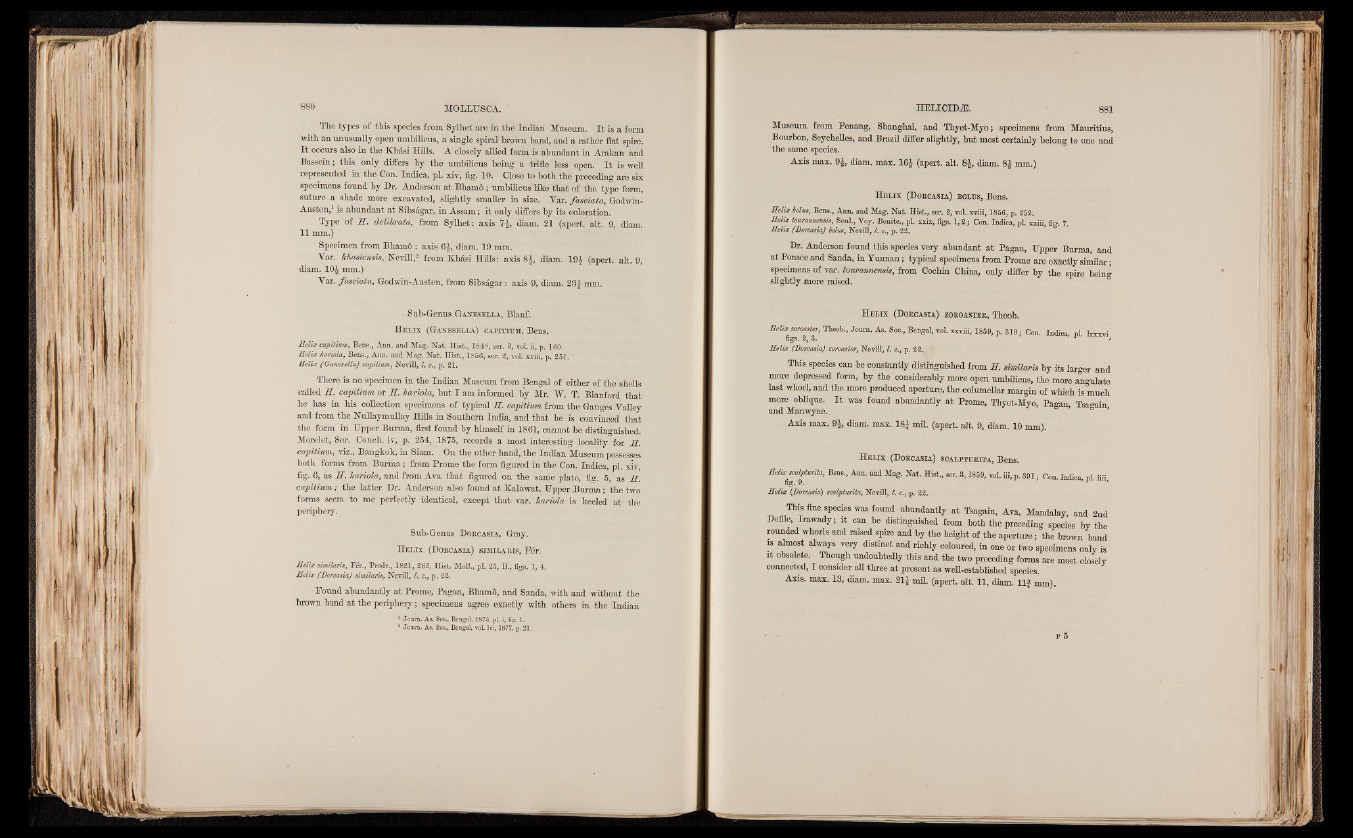
The types of this species from Sylhet are in the Indian Museum. It is a form
with ah unusually open umbilicus, a single spiral brown band, and a rather flat spire.
I t occurs also in the Khäsi Hills. A closely allied form is abundant in Ara>n.n and
Bassein; this only differs by the umbilicus being a trifle less open. I t is well
represented in the Con. Indica, pi. xiv, fig. 10. Close to both the preceding are six
specimens found by Dr. Anderson at Bhamd; umbilicus like that of the type form,
suture a shade more excavated, slightly smaller in size. Yar. fasciata, Godwin-
Austen,1 is abundant at Sibsägar, in Assam; it only differs by its coloration.
Type of K. delibrata, from Sylhet: axis diam. 21 (apert. alt. 9, diam.
11 mm.)
Specimen from Bham6 : axis 6£, diam. 19 mm.
Yar. khasiensis,Nevill,2 from Khäsi Hills: axis 8$, diam. 1 9 | (apert. alt. 9,
diam. 10^ mm.)
Yar. fasciata, Godwin-Austen, from Sibsägar: a.yis 9, diam. 23J mm.
Sub-Genus G a n e s e l l a , Blanf.
H e l i x (G a n e s e l l a ) c a p it iu m , Bens.
Helix capitimi, Bens., Ann. and Mag. Nat. Hist., 1848, ser. 2, vol. ii, p. 160.
Helix hariola, Bens., Ann. and Mag. Nat. Hist., 1856, ser. 2, vol. xviii, p. 251. '
Helix (Ganesella) capitium, Nevill, I. c., p. 21.
There is no specimen in the Indian Museum from Bengal of either of the shells
called B . capitium or B . hariola, hut I am informed by Mr. W. T. Blanford that
he has in his collection specimens of typical B . capitium from the Ganges Valley
and from the Nullaymullay Hills in Southern India, and that he is convinced that
the form in Upper Burma, first found by himself in 1861, cannot be distinguished.
Morelet, Ser. Conch, iv, p. 254, 1875, records a most interesting locality for B.
capitium, viz., Bangkok, in Siam. On the other hand, the Indian Museum possesses
both forms from Burina ; from Prome thé form figured in the Con. Indica, pi. xiv,
fig. 6, as B . hariola, and from Ava that figured on the same 'platè, fig. 5, as B .
capitium ; the latter Dr. Anderson also found at Kalawat, Upper Burma ; the two
forms seem to me perfectly identical, except that- vac. hariola is keeled at thè
periphery.
Sub-Genus D o b c a s ia , Gray.
H e l i x (D o b c a s ia ) s im i l a b i s , Fér.
Helix similceris, Fér., Prodr., 1821, 262, Hist. Moll., pi. 25, B., figs. 1, 4.
Helix (Borcasia) similaris, Nevill, I. c., p. 22.
Pound abundantly at Prome, Pagan, Bhamô, and Sanda, with and without the
brown band at the periphery; specimens agree exactly with others in thè Indian
1 Journ. As. Soc., Bengal, 1875, pi. i, fig. 1.
2 Journ. As. Soc., Bengal, vol. Ivi, 1877, p. 21.
Museum from Penang, Shanghai, and Thyet-Myo; specimens from Mauritius,
Bourbon, Seychelles, and Brazil differ slightly, but most certainly belong to one and
the same species.
Axis max. 9£, diam. max. 16£ (apert. alt. 8J, diam. 8£ mm.)
H e l i x (D o b c a s ia ) b o l u s , Bens.
Helix holm, Bens., Ann. and Mag. Nat. Hist,, ser. 2, vol. xviii, 1856, p. 252.
Helix touramensis, Soul., Voy. Bonite., pi. xxix, figs. 1,2; Con. Indica, pi. xxiii, fig. 7.
Helix (Borcasia) bolus, Nevill, I. c., p. 22.
Dr. Anderson found this species very abundant at Pagan, Upper Burma, and
at Ponsee and Sanda, in Yunnan; typical specimens from Prome are exactly similar;
specimens of var. towramtensis, from Cochin China, only differ by the spire being
slightly more raised.
H e l i x (D o b c a s ia ) z o b o a s t e b , Theob.
Helix^ zoroaster, Theob., Journ. As. Soc., Bengal, vol. xxviii, 1859, p. 310; Con. Indica, pi. lxxxvi
Helix (Borcasia) zoroaster, Nevill; I. c., p. 22.
This species can be constantly distinguished from B . similaris by its larger and
more depressed form, by the considerably more open umbilicus,' the more angulate
last whorl, and the more produced aperture, the columellar margin of which is much
more oblique. I t was found abundantly at Prome, Thyet-Myo, Pagan, Tsagain
and Manwyne. ’ ’
Axis max. 9£, diam. max. 181 mil- (apert. alt. 9, diam. 10 mm).
H e l i x (D o r c a s ia ) so a l p t u r it a , Bens.
Hula gcalpburita, Bens., Ann. and Mag. Nat. Hist., ser. S, 1859, vol. iii, p. 391; Con Indioa nl liii
fig. 9. '*■ »
Helix (Borcasia) scalptwrita, Nevill, I. c., p. 22.
This fine species was found abundantly at Tsagain, Ava, Mandalay, and 2nd
Defile Irawady; it can be distinguished from both the preceding species by the
rounded whorls and raised spire and hy the height of the aperture; the brown band
is almost always very distinct and richly coloured, in one or two specimens only is
it obsolete. Though undoubtedly this and the two preceding forms are most closely
connected, I consider all three at present as well-established species.
Axis. max. 13, diam. max. 21£ mil. (apert. alt. 11, diam. I l f mm).